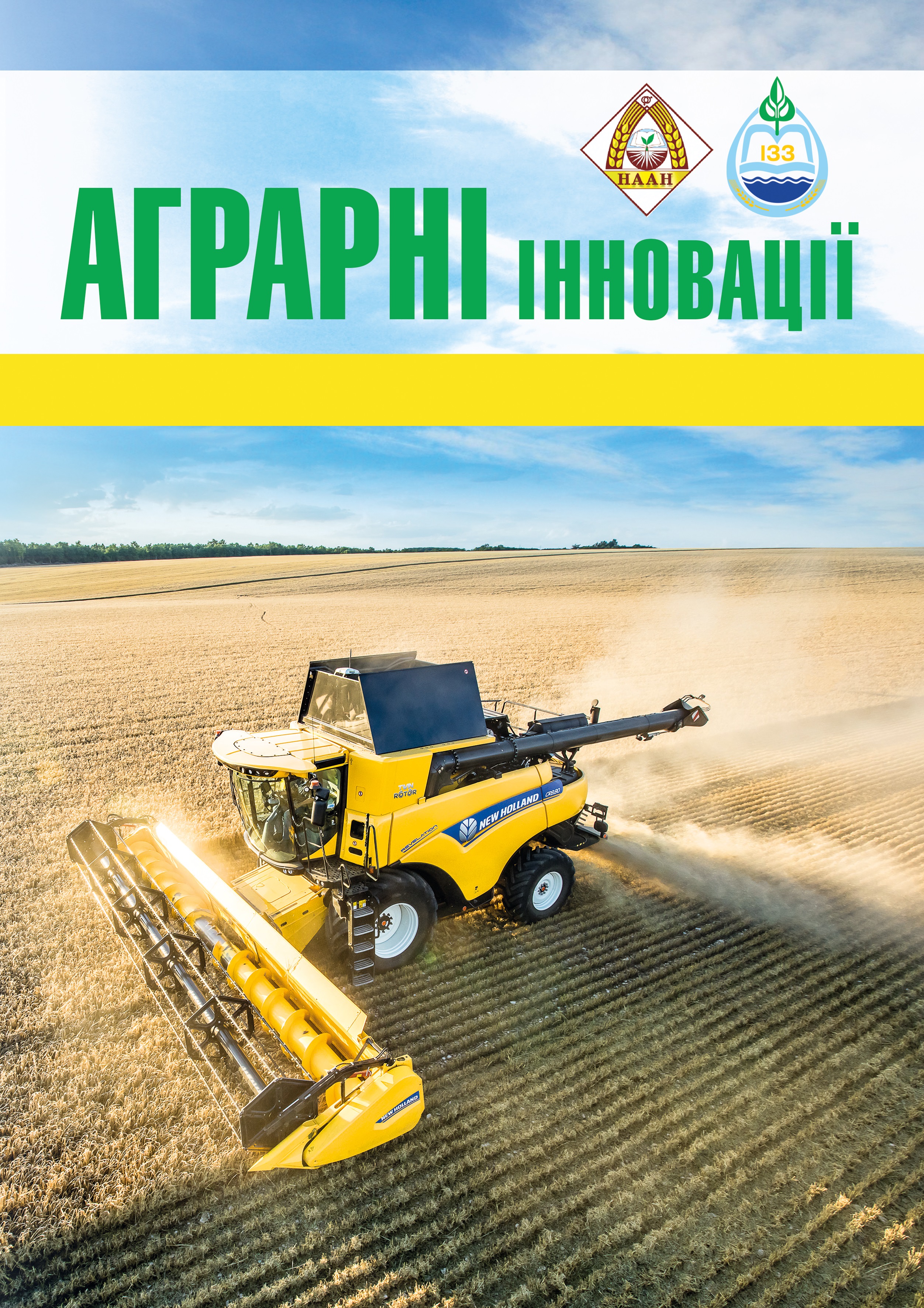THE ROLE OF PHOTO- AND TEMPERATURE REGIMES IN THE FORMATION OF POTATO PLANT PRODUCTIVITY IN VITRO
Abstract
Purpose. The aim of these studies was to determine the effect of the photoperiod, temperature regimes and light intensity on potato tuber formation in vitro. Methods. In experiment № 1, Kobza potato plants were grown in vitro at temperatures of 14–16; 20–22; 24–26°С and lighting 500; 1500; 2000; 3000 lux. In experiment № 2 temperature regime of cultivation day/night 20–22/10–12; 16–18; 20–22°С was studied against the background of photoperiods: recommended by the Institute of potato, ten- and sixteen-hour. Variety Nezabudka was used in the experiment. Results. According to the analysis of variance of the research results, on average over 3 years, the greatest influence on the mass of microbulbs in experiment 1 was the temperature regime (81 %), much less – lighting (15 %). The maximum weight of the average microbulb of the Nezabudka variety was obtained at a day/night temperature of 20–22/10–12°С, regardless of the duration of the photoperiod. Conclusions. The decisive factor influencing the in vitro productivity of the early-ripening Kobza variety is the temperature conditions of cultivation, the light intensity is much less affected. The maximum indicators of plant productivity in vitro were obtained using a temperature of 14–16°С and illumination of 3000 lux. The number of microbulbs per plant was 1.2, the weight of the average microbulb – 262.0 mg, the mass of microbulbs per plant - 363.7 mg, the number of microbulbs weighing more than 350.0 mg – 20.9 %. Temperature conditions were also a decisive factor in the formation of plant productivity in vitro of Nezabudka potato variety. The maximum indicators of tuber formation and the largest mass of microbulbs on all studied photoperiods were obtained at night temperature 10–12°С: 98.9; 99.5 and 99.3 %; 359.3; 356.1; 336.1 mg. Therefore, cultivation temperature conditions have a much greater effect on potato productivity in vitro than light intensity and regimes.
References
2. Palmer C. E., Smith O. E. Effect of kinetin on tuber formation on isolated stolons of Solanun tubero-sum L. cultured in vitro. Plant Cell Physiol. 1970. 11 (2). Р. 303–314.
3. Koda Y. Factors controlling potato tuberization. Memor. Fac. Agr. 1988. 16 (1). Р. 88–128.
4. Akita M., Takayama S. Induction and development of potato tubers in a jar fermenter. Plant Cell Tissue and Organ Culture. 1994. 36 (2). Р. 177–182.
5. Овчинникова В.Н., Мелик-Саркисов О.С., Фаддеева И.Н. Индукция клубнеобразования in vitro пониженными температурами. Вест. с.-х. науки. 1987. № 7. 81–85.
6. Ewing E.E. Heart stress and the tuberization stimu-lus. Am. Potato J. 1981. № 58 (1). Р. 31–49.
7. Ranalli P. The canon of potato science: 24. Microtubers. Potato Res. 2007. № 50. Р. 301–304.
8. Лавриненко Ю.О., Балашова Г.С., Котова О.І. Вплив температурного режиму культивування та кон-центрації мікросолей у живильному середовищі на бульбоутворення картоплі в культурі in vitro. Таврійський науковий вісник. Херсон, 2017. № 98. С. 82–88.
9. Лавриненко Ю.О., Балашова Г.С., Котова О.І., Добринкіна К.О. Вплив вітазиму, температурного режиму та розміру пробірок на інтенсивність бульбоутворення картоплі сорту Тирас в культурі in vitro. Зрошуване зем-леробство. 2013. Вип. 59. С. 149–152.
10. Дерябин А.Н., Юрьева Н.О. Экзогенная регуля-ция клубнеобразования у Solanum tuberosum L. в куль-туре in vitro (обзор). Сельскохозяйственная биология. 2010. № 3. С. 17–25.
11. Артюхова С.И., Киргизова И.В. Биотехноло-гический способ размножения оздоровленного кар-тофеля Западной Сибири микроклубнями в условияхin vitro. Современные наукоемкие технологии. 2014. № 12. C. 107–114.
12. Мелик-Саркисов О.С., Фадеева И.И. Исполь-зование эффекта клубнеобразования в биотехнологии картофелеводства. Вестник сельскохозяйственной науки. 1989. № 9. С. 86–91.
13. Zaag D. Potatoes and their cultivation in the Netherland. 1980. С. 18–41.
14. Кокшарова М.К. Влияние температурного режима на образование микроклубней картофеля в культуре in vitro. АПК России. Т. 23. № 2. С. 278–281.
15. Hussey G., Stacey N. J. Factors affecting the for-mation of in vitro tubers of potato (Solanum tuberosum L.) Annals of Botany. Vol. 53. Iss. 4. P. 565–578.
16. Бугаєва І.П., Сніговий В.С. Культура картоплі на півдні України. Херсон, 2002. С. 126.
17. Lorenzen J.H., Ewing E.E. Changes in tuberization and assimilate partitioning in potato (Solanum tuberosum L.) during the 1st 18 days of photoperiod treatment. Ann. Botany. 1990. № 66 (4). Р. 457–464.
18. Effects of illumination source, culture ventilation and sucrose on potato (Solanum tuberosum L.) microtuber pro-duction under short days / Alix By M.J. et al. Ann. App. Biol. 2001. № 139 (2). Р. 175–187.19. Garner N., Blake J. The induction and development of potato microtubers in vitro on media free of growth-reg-ulating substances. Ann. Bot. 1989. № 63 (6). Р. 663–674.
20. Оздоровлення картоплі в культурі in vitro: науково-методичні рекомендації / Р.А. Вожегова та ін. Херсон, 2013. 20 с.






